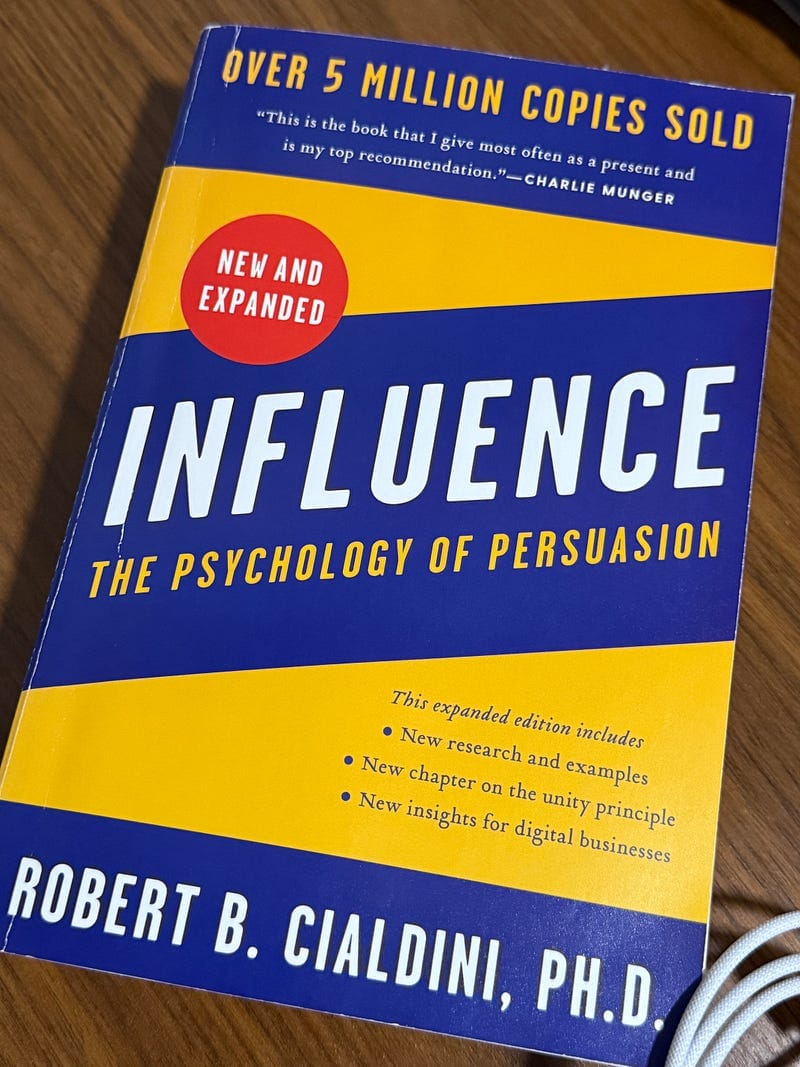
Why a Sense of “Us” Can Make (or Break) Our Choices
Would you loan your car to a complete stranger? Probably not. But what if that stranger casually mentions they grew up in your hometown or flashes a badge from your alma mater? Suddenly, they don’t feel so “strange” anymore, right? We’re all a bit more trusting when we sense someone is one of us. That’s the Unity principle at work. Unity focuses on shared identity: the feeling that you and another person belong to the same family, tribe, or team. When we see someone as part of our group, we’re remarkably inclined to say yes to them. In fact, we’re so wired for unity that we might consider giant favors for an in-group member. Favors we’d never even consider for outsiders.
Summary
Robert Cialdini added Unity as a seventh principle of persuasion because it cuts deeper than casual similarities or simple charm. It’s not just “Hey, that person is like us,” but rather “That person is of us.” Once we sense a “we’re in this together” vibe, every other influence tactic, like social proof or scarcity, gets an extra jolt. Unity has been around forever, invisibly amplifying how we bond and whom we trust, and now it’s finally front and center.
In this chapter, we’ll break down the central ideas of Unity, share a few personal reflections, and then dig into how we can use it in day-to-day life. Ever struck up an instant friendship with a total stranger over a shared accent? Ever felt a weirdly intense loyalty to your group or club? That’s Unity in action.
Core Ideas
Shared Identity = Strong Influence
Unity stems from one core truth: people are more likely to say yes to someone they consider “one of us.” If you feel a person shares your tribe, be it family, religion, nationality, or even an alumni connection, your defenses tend to drop. This sense of belonging can spring from all sorts of markers: hometown, taste in music, membership in the same association. If it’s a meaningful identity, it bonds people.
Family First (Kinship and Genetics)
Among all possible ties, family is the top unity cue. We’ll do almost anything for a relative. Think about it: you’d run into a burning building to save your sibling faster than you’d do the same for a coworker, right? Cialdini notes how we’re far more willing to go the extra mile for someone who shares our genes. Interestingly, clever persuaders can create a family-like tone even without actual family bonds. In one example, Cialdini boosted parents’ survey response rates by offering a trivial reward to their kids, effectively saying, “Help your child,” and compliance shot up to 97%. Simply suggesting a family vibe, “do it for your kid,” triggered near-instant agreement. Goes to show that “family” can mean more than blood ties.
Beyond Blood — Tribe, Team, and Shared Causes
Unity isn’t strictly about genetics. It also pops up from group identities that define us. Think national pride, cultural heritage, or even hardcore sports fandom. If you’ve high-fived a stranger just because they wore the same team jersey, you’ve felt that tribal pull. When people share strong beliefs or values, the sense of unity can be just as potent, like a network of activists fighting for a cause, or members of a fraternity with shared traditions. Politicians capitalize on this all the time. They’ll drop references to local customs or call out, “As fellow moms and dads…” to tap that feeling of oneness. Sometimes it’s subtle, maybe just a bit of local slang or a mention of a regional favorite. But it often works like magic to make an audience think, “Yes, this person is one of us.”
Acting Together Unites Us
Another angle, moving or acting in unison, can build unity surprisingly fast. Think of a crowd chanting in sync, a team dancing together, or an entire office doing a volunteer day side by side. There’s a reason armies have soldiers march in lockstep. Coordinated movement gets people into a shared groove. If you’ve ever joined a silly group game at work or tackled a tough project as a team, you’ve felt how that common effort brings you closer. Even just asking someone for advice can create a mini “we”. Once they’ve contributed ideas, they feel invested in the outcome.
Proximity and Togetherness
Living in the same place or working closely over time can also foster unity. Neighbors who’ve spent years lending tools or sharing holiday meals often feel like extended family. Cialdini mentions that even treating a visitor like a household member, letting them rummage in the fridge, for instance, sends a potent signal: “You’re one of us.” The longer we coexist or collaborate, the more we settle into that warm sense of “our home team.”
The “We” Boundary (Us vs. Them)
Flip side: deciding who’s “us” automatically defines who’s “not us.” Unity is great for bonding, but it can also draw lines in the sand. History is full of examples where leaders whipped up an “us-versus-them” mindset to rally their base, sometimes to harmful extremes. When used well, unity can encourage beautiful acts of compassion and teamwork. When weaponized, it can fuel prejudice or exclusion. Cialdini noticed rising tribalism in modern times, which is one reason he introduced Unity as a formal principle. It naturally boosts loyalty inside the circle, sometimes at the cost of fairness or empathy for those outside it. It’s a strong force, so handle it with care.
Unity vs. Liking (Similarity on Steroids)
Unity may resemble the Liking principle. Both involve seeking common ground. But there’s a key difference: Liking is “hey, we have something in common,” while Unity is “hey, we’re fundamentally the same group.” It’s the gap between “She’s like us” and “She is one of us.” The second packs a bigger punch. With Unity, another person’s achievements or screw-ups feel like they’re happening to us. That’s why betrayal by a close friend or teammate hurts more, and why praise from a fellow insider feels extra special. Unity engages our deep need to belong.
Personal Insights
Thinking about Unity reminded me how quickly I’ve opened up to strangers after discovering a shared hometown or college major. There’s something oddly comforting about hearing, “Wait, you too?” In a previous job, I remember meeting a colleague who turned out to be from my tiny hometown. Within an hour, he offered to help me find an apartment. Normally, I’d never accept such a big favor from someone I’d just met, but he no longer felt like a random coworker. He was “one of us.”
I’ve also been in groups where that same bond shut out newcomers, leaving them feeling alienated. It wasn’t intentional, but our unity was so strong that outsiders had a hard time breaking in. It was a wake-up call for me: unity can exclude just as much as it includes. You end up with an invisible line. If you’re in, it’s awesome. If you’re out, it stings.
I’ve even caught myself changing my opinions because a person I view as an “insider” endorsed something. It’s such a sneaky bias. The more I see it, the more I realize how easily we can be swayed by “us” vibes. On the flip side, I also appreciate how uplifting it feels to share that “we” moment. I recall a concert once where everyone belted out the same lyrics, arms around each other, total strangers acting like family. That sense of unity is magical and deeply human.
Practical Applications
1. Highlight Genuine Commonalities
If you want to connect or persuade, lead by pointing out a real shared identity. It could be a common origin, interest, or belief. People respond quickly to “I’m from there, too!” but only if it’s authentic. Faking it? You’ll lose trust in a flash.
2. Use “We” Language
Pay attention to pronouns. Instead of “I want you to do this,” try “How can we solve this together?” Subtle shifts like “we,” “us,” or “our” can spark an instant sense of team. Just avoid going overboard to the point where it feels forced or pandering.
3. Invite Co-Creation
Asking people to advise or help you is a sneaky-strong unity builder. Once they share ideas, they’re part of the cause. Next time you want buy-in, ask for genuine input rather than pitching a done deal. Co-authorship leads to co-ownership.
4. Create Rituals and Traditions
Simple group rituals, from “Team Donut Fridays” to a shared cheer at the end of meetings, can bind people together. Humans thrive on routine gatherings or traditions that say, “This is what we, as a group, do.” Keep it fun and inclusive, and watch camaraderie bloom.
5. Embrace Shared Experiences
Joint experiences, like tackling a volunteer project or conquering a ropes course, work wonders for unity. Think about challenging people to do something together rather than alone. It doesn’t have to be extreme. Even a group walk-and-talk can weave a story of “we did this side by side.”
6. Watch for “False We’s”
Stay alert to folks who claim “we” without legit reason. If someone keeps saying “we’re basically family” after 30 seconds, you might want to step back and evaluate their motives. Also, be mindful of using “us vs. them” language that might alienate others or turn tribal energy negative.
7. Expand Your “Us”
Take a step to widen your circles. Seek friendships or experiences that cross typical group boundaries. Living in a diverse neighborhood, traveling, or simply hanging out with folks from different walks of life can cultivate a broader sense of “we’re all in this together,” which curbs prejudice and fosters empathy.
Additional Resources
- Influence, New and Expanded Edition by Robert B. Cialdini — The updated version of Cialdini’s classic reveals how Unity fits alongside other principles like Reciprocity, Liking, Social Proof, Authority, Scarcity, and Commitment/Consistency. Perfect if you want the original source from the master of persuasion himself.
- Pre-Suasion by Robert B. Cialdini — This follow-up to Influence digs deeper into how to set the stage for influence before you even make a request. The Unity principle takes center stage, showing how simple shifts in framing can create a shared identity that makes people receptive.
- The Power of Us (Jay J. Van Bavel & Dominic Packer) — Examines the science behind group identities and how they shape our thinking. Offers plenty of research findings on tribalism, belonging, and how to harness them for good, from sports stadiums to boardrooms.
- Science of Persuasion (Animated Video) — A short video co-created by Cialdini and team that summarizes all the classic principles (including a nod to Unity). Helpful if you’re looking for a quick, visual refresher.
By exploring Unity, you’ll discover just how social we really are, and how powerfully “one of us” can sway our decisions. Harness that force thoughtfully, whether you’re building a team or forging friendships, and be ready to spot when someone else tries to wave the “we” flag just to nudge you. When used wisely and sincerely, Unity isn’t just about persuasion, it’s about the uplifting, deeply human bonds that keep us together.
Enjoyed this piece?
If this piece was helpful or resonated with you, you can support my work by buying me a Coffee!

Become a subscriber receive the latest updates in your inbox.






Member discussion